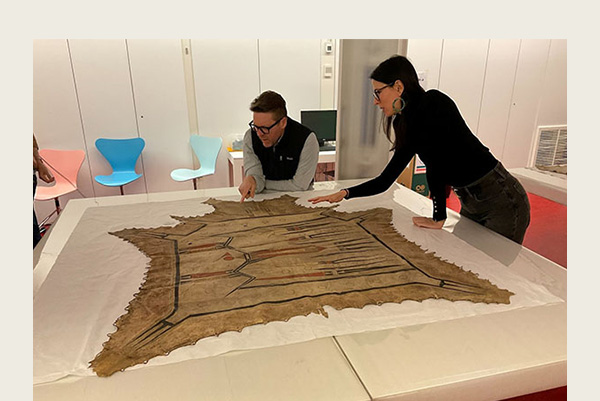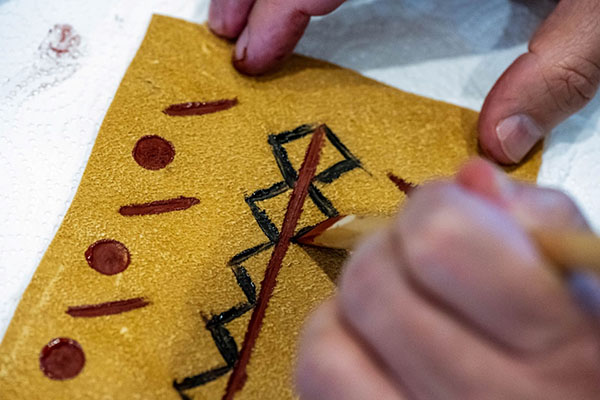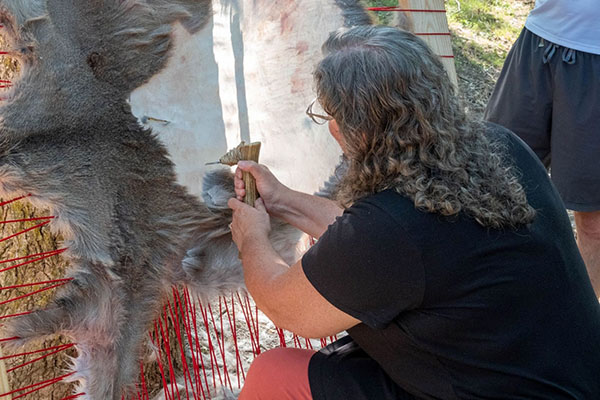Minohsayaki ‘Painted Robes’ Exhibition at Miami University gives voice to Peewaalia and Myaamia peoples
The exhibition, which runs from Jan. 30 through June 8, will feature a number of recent examples of painted deer hides and document the process of revitalization of this tradition after its decline from the 1700s.

Minohsayaki ‘Painted Robes’ Exhibition at Miami University gives voice to Peewaalia and Myaamia peoples
The Richard and Carole Cocks Art Museum (RCCAM) at Miami University is honored to partner with the Myaamia Center at Miami University and the Miami Tribe of Oklahoma. With this exhibition, Minohsayaki ‘Painted Robes,’ the art museum is collaborating for the first time with the Peoria Tribe of Oklahoma. Maintaining a community-curated approach, this exhibition is created in the voices of Peewaaliaki ‘Peoria Indian’ and Myaamiaki ‘Miami Indian’ people.
“More than an exhibition about the beautiful minohsayaki, this exhibition delves into the emotional and educational journey of reclamation and passing down heritage to new generations of Peewaalia and Myaamia,” said Jason Shaiman, curator of exhibitions at the art museum.
Minohsayaki ‘painted hide robes’ are an art form that was practiced by both the Peewaaliaki and Myaamiaki prior to contact with Europeans. Minohsaya artists produced many beautiful examples of this art form in the late 1600s into the early 1700s. In the mid-1700s, the artistic practice of producing minohsayaki declined.
The exhibition, which opens on Jan. 30, will feature a number of recent examples of painted deer hides and document the process of revitalization of this tradition after its decline from the 1700s. The story of revitalization is an important one, alongside the revitalization of language and other cultural traditions.
Ironstrack said, “After decades of our community looking at these beautiful minohsayaki from afar, it was quite emotional to be in the same room as these ancestral objects — to touch where their hands created such lasting beauty, and to speak our language and tell our stories in their presence."

The exhibition and related programs are supported by a grant from the Andrew W. Mellon Foundation through the Humanities Without Walls Consortium, which is administered by the University of Illinois. and is part of the Reclaiming Stories project.
Free and public programs in connection with the exhibition include:
- A webinar at noon Thursday, Feb. 22, in partnership with the Alumni Association of Miami University. The webinar will include a discussion with George Ironstrack, Miami Tribe of Oklahoma and assistant director of the Myaamia Center, and Elizabeth Ellis, Peoria Tribe of Indians of Oklahoma and associate professor of History at Princeton University.
- An in-person public lecture entitled “Requickening and Awakening the Dormant” will take place at the museum at 3 p.m. Saturday, March 16, with Michael Galban (Washoe and Mono Lake Paiute), historic site manager of Ganondagan State Historic Site and the curator of the Seneca Art & Culture Center, who has contributed to the efforts to revitalize the painted hide tradition.
Preparation for this exhibition has involved travel by members of the Myaamia and Peoria Tribe to the Musée du Quai Branly - Jacques Chirac in Paris, France, where several painted robes and other painted deer-skin objects acquired during the 1600s and 1700s during the peak of French colonization of North America are currently stored and displayed. A particular object (not shown in this exhibition), will be represented in a photo-mural, and likely depicts an image of the Thunderer or Thunder Being, and was probably made by a member of the Illinois Confederacy, and may have been similar to those made and used by Miami and Peoria Tribes in the Midwest. These incredibly important and rare objects, which are seldom preserved in North America itself, do not typically travel.

The visits provided the opportunity to look closely at the centuries-old painted hides and gain new insights and understanding, which could inform the revitalization of the painted hide tradition. Workshops taking place in Miami, Oklahoma in 2022 and 2023, attended by Miami Tribe, Peoria Tribe members and staff of RCCAM, enabled community members to come together to try preparing and painting hides.
"It is tremendously exciting to witness and support the revival of our ancestral art and storytelling practices,” said Elizabeth Ellis, who also serves as tribal history liaison for the Peoria Tribe of Indians of Oklahoma. “Our history and the beautiful painted robes continue to have deep importance for our communities and to convey teachings to our people."
The Miami University exhibition will be open through June 8. To find out more about the exhibition and the project, visit the RCCAM and Myaamia Center websites, as well as the Reclaiming Stories project page.
Robert Morrisey, associate professor of history at University of Illinois and member of the Reclaiming Stories project: "The creative work in this project is not just recovering meaning or understanding history but bringing to life these important painting practices. It's really about revitalization."